
Gathering place for Herreshoff Eagle owners and admirers.

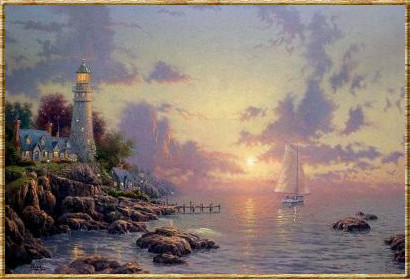 |
Come now, oh friend, and sail with me Upon the tranquil, calming sea. I search not for a chest of gold Not for fine pearls or treasure olde; I search instead for that which we Will find now in Tranquility. |
Subj: RE: Herreshoff Eagle
Date: 3/15/2004 2:58:27 PM Mountain Standard Time
From: HALSEY@HERRESHOFF.ORG To: GMayhak@aol.com
The Eagle was planned and first built in the early 70s by Nowak & Williams of Bristol, Rhode Island, my home town. Initially, we designed the Herreshoff America catboat that proved to be a sturdy yacht of rather conventional catboat proportions but with a bit more sail than traditionally.
The Eagle hulls came from the same mold, but the rig was very different, having an effective headsail and optional topsail that enhanced performance in light air conditions. As expected, the Eagle proved a much better sailor than the Herreshoff America. I sailed these boats quite a few times. They were popular, but I dont remember how many were built by Nowak & Williams or the successor companies, Squadron Yachts of Bristol, Rhode Island or Nauset Marine of Orleans, Mass.
I am pleased that there is now an organization to perpetuate the viability of these useful pocket yachts.
Halsey C. Herreshoff of Herreshoff Designs, designer of the Eagle.
From the back cover of The Sailor's Handbook... "The Sailor's Handbook was compiled with the help of experts from all the worlds major sailing centers. The American editor, Halsey C. Herreshoff, is one of the worlds foremost naval architects, who navigated Courageous to victory in the 1974 America's Cup."
Herreshoff Eagle "Greta Garbo"
|
She's now living in the Sea of Abaco, in the Bahamas. I trailered her down to Florida from Michigan, and sailed across. Clicking on the picture will take you to a web album that describes the trip and all the work we've done, along with some of the fun since she got to the Island. With her shallow draft and sea-kindliness, she is a perfect boat for the Bahamas, and her beautiful lines make her welcome wherever we go. |
1974 Hull # unknown |
Herreshoff Eagle "Miss Savannah"
Miss Savannah is for sale: $13,500 OBO
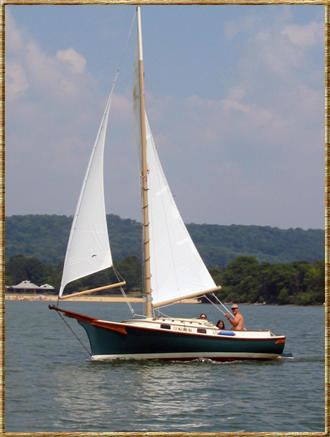 |
Nowak & Williams, Bristol R.I. 1974 Hull #111 |
|
After two years of proud ownership, I have completed my restoration of the Miss Savannah. Below is some of the work done on the boat. Rigging: Replaced all the sheets and halyards with English POSH line, added a teak and bronze block (5 to 1) mainsheet system, new Bristle Bronze turnbuckles on the shrouds, new teak mast hoops, new SS steering cables, installed a custom above boom mast hinge fabricated by Com-Pac Yachts, and repainted all the spars. |
 |
 |
Custom Sunbrella full-boat
cover, and Bimimi.
|
|
Engine: Installed a Honda
5HP 4-stroke in the well, with remote cables to a single lever side
mount shifter. This allows throttle control and shifting from the cockpit,
similar to an inboard installation
|
 |
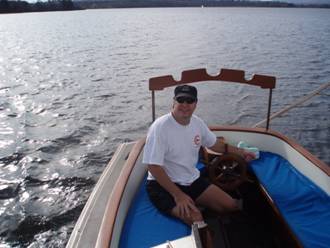 |
Hull / Deck: Restored
the gelcoat and teak (finished with Cetol), replaced the port lights,
installed a bronze and mahogany boom gallows
|
|
Sails: New jib and Quantum main with two reef rows |
 |
 |
Trailer Rebuild: Completely rebuilt dual-axle trailer from the frame up (new axle, new hubs, new surge breaks, new jack, new lights, new tires, winch cable, etc) |
|
I found her down on the Jersey
Shore.
|
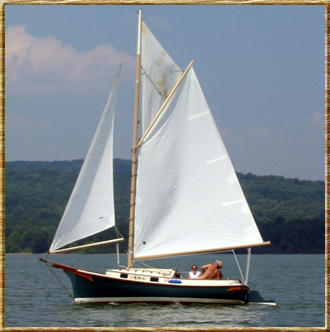 |
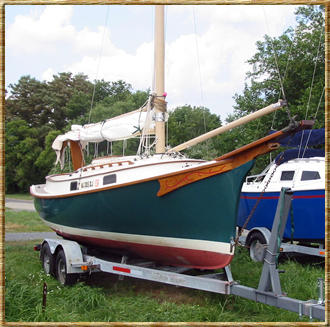 |
We have rebuilt the trailer,
as we dry sail her on Spruce Run in Clinton, NJ.
|
|
We installed an above boom mast hinge to make trailering easier for weekend trips to the Long Island Sound . I had the hinge fabricated by Com-Pac Yachts.
|
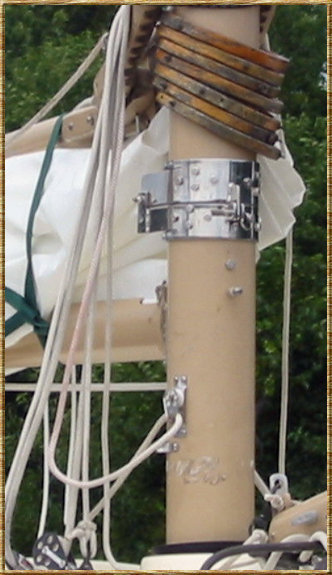 |
Herreshoff Eagle "Tranquility Base"
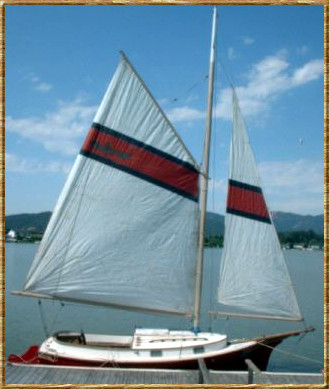 |
Nowak & Williams, Bristol R.I. 1975 #120 Gary & Veena Mayhak. New River, Arizona.
|
|
Replaced the opening port with a nice heavy one with bug-screen. Lots left to do but we hope to have her on the water this spring! |
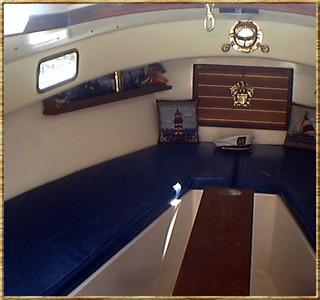 |
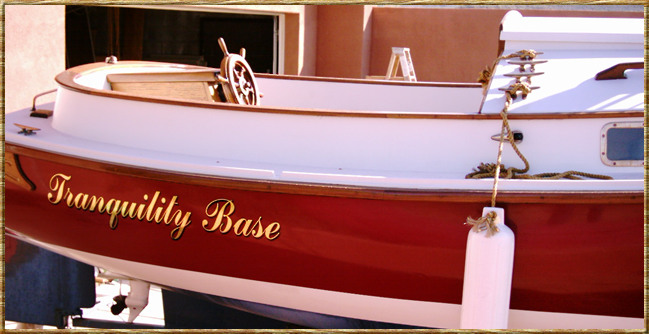
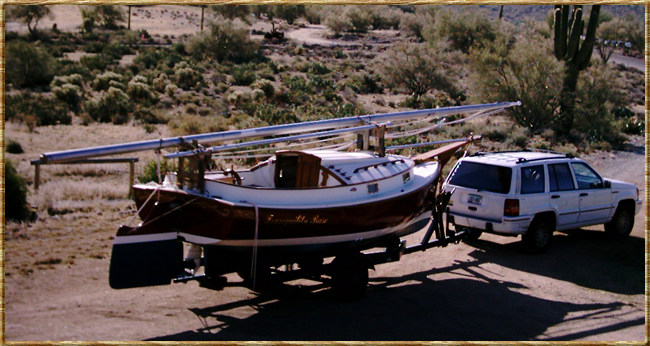
Stripped the mast & spars to bare aluminum. I'll wait until winter to finish them, summer is here and it's time to go sailing!
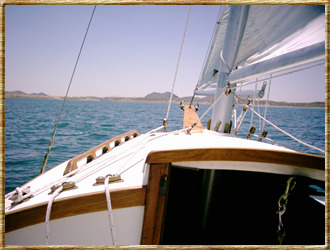 |
Having only sailed my full keel Pacific Seacraft Flicka I was very surprised at how fast and stable the Eagle is! The first day out the wind was about 15 knots with gusts to 25, I didn't reef the main but kept my hand on the main sheet. I was really pleased with the performance when I realized at the end of the day that I hadn't lowered the centerboard! Today ( 6-1-04) I sailed her with the centerboard down and was happy to find that she can point pretty close to the wind. The 8 hp Johnson does a great job pushing the Eagle with power to spare! These are cool little yachts :-)
|
Herreshoff Eagle "Bliss"
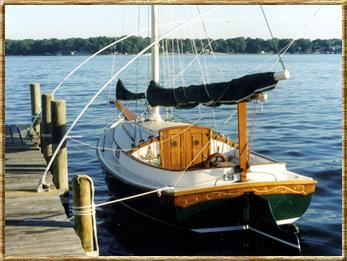 |
Nowak & Williams, Bristol RI 1973 #039 Walter & Credwyn Goos, Brick, New Jersey |
|
Dave's got the only other
Eagle in this area of New Jersey (I live on the Metedeconk River, which
empties into the top of Barnegat Bay,) and he had his before I found
mine stored in a stone barn in Red Hook, NY.
|
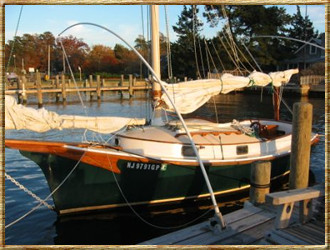 |
 |
Herreshoff Eagle "Spirit"
 |
Squadron Yachts, Bristol RI 1976 |
|
on Chesapeake Bay
full canvas! |
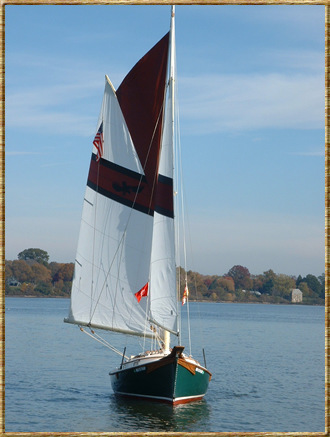 |
 |
Salty little ship! |
|
Beautiful tanbark sails!
|
 |
Herreshoff Eagle "Linda"
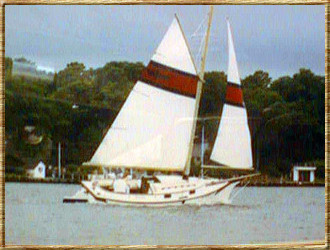 |
Nowak & Williams, Bristol RI 1974 #079 |
|
I have restored her, painted the hull white and sail her in New Jersey along with Walter and his Eagle.
|

|
 |
My boat has the Teak option, no mahogany. I have owned her for about 7 years. |
Herreshoff Eagle "Salty"
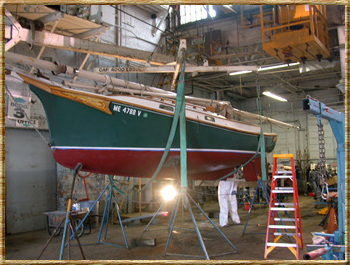 |
| My Eagle is still under its winter tent. However, I have been working on it diligently in the last week. I have removed all the bronze hardware and all the electrical. I intend to polish all the bronze and all of the electrical in the next week or two. I also have purchased new bronze navigational lights from Perko that I will add (my Eagle currently has no nav lights). Then, once it is warm enough here in Maine, I intend to remove the tent and refinish the deck with a new non-skid surface. That, along with the new bronze should make the boat look pretty good for the sailing season. |
I must confess that the electrical system on my Eagle was completely crazy. If possible, I would love to get some digital pictures of where your electrical panel is located (if your Eagle has one). With regard to the rigging, I have replaced all of the halyards (more as a precaution since I do not know the history and they looked to be on the older side) and I will soon replace the plastic mast hoops with wood hoops that I purchased from Pert Lowell in Massachusetts. My mainsail is currently being "rejuvenated" by a small sail maker in Cape Cod who has fixed sails for me before.
My boat was originally located in Belfast, Maine and was used as a prop in the Mel Gibson movie "Man Without a Face" which was filmed in Maine. Its original name was "Salty". I was told that the original owner was the harbor master in Belfast. The second owner was Peter Mullen, located here in Portland. He owned the boat for only one season. I am very excited to get my Eagle on the water this Spring. While I don't have any good pictures of her right now, above is a picture of her getting ready to go in the water last Spring which I received from the previous owner.
Update... 9-15-04
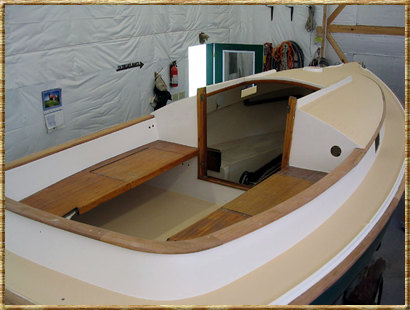 |
I have stripped the decks
bare (they were not original anyway) and painted both the decks and
cockpit sole with Intelux Interdeck non-skid in beige. I also repainted
the cabin trunk and cockpit surround in white.
|
|
I am about halfway through stripping the brightwork and intend to finish with Cetol light. I have removed the bowsprit and trim boards for refinishing in my basement. I have also removed much of the bronze for polishing and rebedding. |
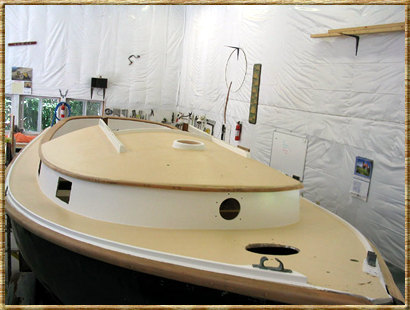 |
UPDATE 5-25-05... She is very near completion (for this season anyway) and I am looking forward to a launching in early June. I would be remiss if I did not thank Tim Lackey of Northern Yacht Restorations () for all of his work and advice related to my Eagle. If you or any other Eagle owners need work performed on their boats or need parts fabricated for their boats, I highly recommend Tim. He loves boats, is honest and fair with his pricing, and does excellent work. Best regards, Brian
Latest pictures are in the
Herreshoff Eagle "Maru Vehine"
 |
|
Mainsheet from mast to jamcleat.
Single reefed |
 |
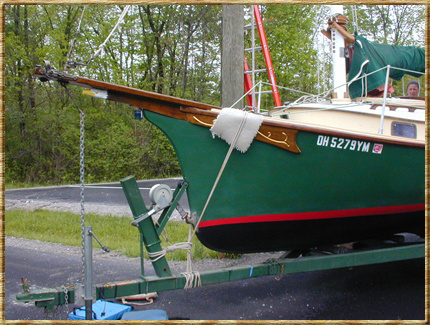 |
Ready to launch
|
|
Here is a picture of the
boat at its mooring site, It is very rare that I keep it at the dock.
This way it can handle anything the weather throws our way. This is
also the view I have of the boat from my deck at the house.
|
 |
Herreshoff Eagle
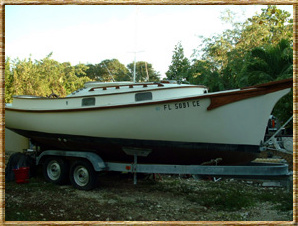 |
Nowak & Williams, Bristol RI 1976 #121 |
|
I haven't decided on a name
yet. She has a white hull and the original white and red sails. The
only non standard mod I've noticed is a roller furling jib. I bought
her on e-Bay and towed her up from Florida a couple of weeks ago. She
has been out of the water for a few years and the woodwork was badly
weathered, so I'm refinishing it. While I have the mast out I'm also
wiring her for electricity and installing a radio antenna. The only
major thing she seems to be missing is a topsail. I will keep her at
a marina south of Annapolis, Maryland.
|
Herreshoff Eagle
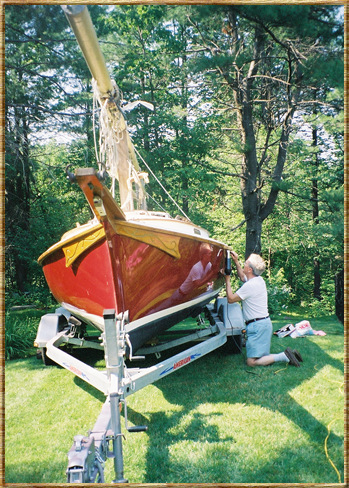
|
Nowak & Williams, Bristol RI 1974 #109 |
|
It has the teak option. I have completed removed all of the old varnish from all the teak and am now preparing all the trim for a re-varnish. Im following the recommendations from the series of 3 articles written by Rebecca Wittman and published in Wooden Boat # 81-83. If anyone would like copies of these excellent articles, I can provide them. Im also re-painting the decks and cabin as well as the masts. My book that came with the boat contains the original paint colors, manufacturers and #s, so that I can make it authentic. However, A picture in the book from 1986 shows the hull as green, but I like the current red. |
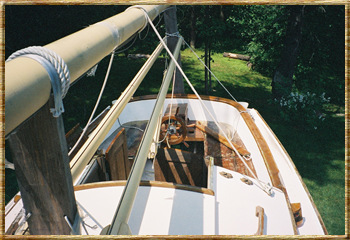 |
Herreshoff Eagle "Allegro"
Allegro is available
for purchase. $6500 including trailer! SOLD
 |
Nowak & Williams, Bristol RI. 1974 #52 |
|
I'm out west on Puget Sound. Specifically, Bellingham Bay not too far from Vancouver, BC. We are a partnership of three guys and have had the Eagle since last fall. Our particular hull seems to have migrated a lot, having last been registered in Hawaii. We have made some modifications from the original design. So far, as luck would have it, all changes have worked out for the better, some more than others. What we changed: 1. Built a new rudder, 50% smaller than the original. And, we put a "foot" on it, a 6" wide faired off board glued and screwed to the bottom edge. The meaning is to direct the water along the side of the rudder rather than it falling off the bottom immediately and losing it's "turning" force. We are having better luck tacking in higher winds and swells. The significant adverse "weather" helm is much diminished. An added benefit: the tiller is much less likely to part under bending stress since the opposing force of the rudder is less. We are still observing rudder behavior and haven't tossed the original rudder yet, either. 2. We have added a second rank of reef points to the main sail and a rank to the jib. The boat is much easier to handle and more comfortable in winds above 15 knots. It toots along quite nicely at 20 and we have been out in gusts to 25. With the jib reefed and the main with 2 reefs in, the boat sails balanced. The second set of reef points has the same sort of haul-out line as the first rank, and it leads forward on both sides of the boom to new cleats. You can leave the tiller to itself for quite a long time and the boat will keep it's course. Very nice when you're out in a blow and have other things to deal with. 3. We removed the jib-boom, and are flying the jib loose-footed. The two jib sheets are fairlead to blocks at the shrouds. This ofcourse means there's an extra line, with the two new sheets. About the same as many other jib rigs. WE feel much safer going out on the bow to put in or take out the jib reefs. The jib seems to take a better shape, too. 4. This change is yet to come, but we plan to add another headstay, running it to somewhere opposite the peak halyard. This will put the pull of the headstay in opposition to the pull of the shrouds and decrease any excess bending in the mast. The is quite a distance between the forward pull of the headstay and the rearwards pull of the shrouds as it is rigged now. The new headstay will still attach to the bow sprit, next to the original. We're saving the original headstay for a little extra support when flying the topsail and for future experiments with staysails, genoas, spinnakers. 5. Our boat had no navigation lights, so we have added side-lights, a masthead light and a stern light. I just got the switching panel a few days ago, so it remains to ferry out the battery and complete the wiring. We bought a new 4-cycle outboard and I added an alternator option to charge the battery from when out cruising. I've been out sailing nearly every day this summer, although we did put the boat out of commission a few times to do the above fixes. I think all three of us partners in "Allegro" are pleased with the boat. When we haul out for the winter, we'll be concentrating on creature comforts in the cabin, maybe an electric inboard, and the usual painting and spiffing up. With all this activity, we haven't managed to get out of Bellingham Bay, though I took it to the south end one day for a visit to Eliza Island. Maybe about 14 miles round trip, but it's a start! |
Herreshoff Eagle " "
|
She was sitting in a back yard, under magnolia trees, up on stands, no stick, but new paint on her hull, waiting for a new owner. Upon inquiring, found she was under reconditioning but a long way to go and the owner had too much on his plate, so I wound up with her. Most of her parts are in boxes, mast and spars complete, main and headsail while somewhat soiled, in pretty good condition. Since her arrival, I've sanded her cabin top, sides, and decks and about to put on paint. I've sanded her spars and mast and also about ready to paint. Hopefully painting will go on this week as a splash date is rapidly approaching, which brings the most serious question. I think I need a rigging plan. The chainplates are in place, the hardware is in place on her mast, but the stays are not complete and I'm going to have to build what I'm short. Is there a printed plan out there? Can anyone offer help? I'll post some pics in a few days, I'm really excited about getting her in the water but most of my time has been on her restoration and hasn't been on documenting her rebuild. I'd be interested in powering bilge pumps, lights, radios, etc. I'll be using a 9.9hp outboard until a 8hp Yanmar can be rebuilt. Looking forward to feedback on my little beauty and getting to know all of you. |
1974 # |
Herreshoff Eagle "Nani Moku"
|
|
Nowak & Williams, Bristol RI 1974 #107
|
|
I recently joined the group and thought you might be interested in seeing some pictures of my boat. By the way, it's a wonderful website and I'm extremly appreciative that you've taken the time to do it.
|
 |
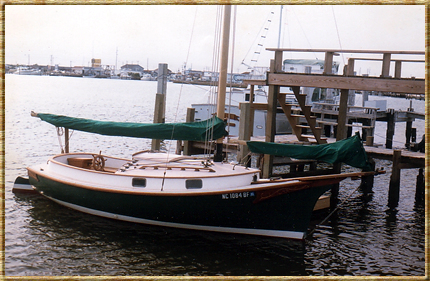 |
I've owned the "Nani Moku"
since 1988. She was built in 1974 by Nowak and Williams and is hull
#107. I have primarily sailed her on the North Carolina coast, in the
Beaufort/Cape Lookout area, and at an inland lake(Lake Norman)close
to Charlotte,NC.
|
|
At this time, she's in my
back yard getting ready to undergo a complete restoration. I'm looking
forward to doing this work myself so I'm sure you and the group will
be getting plenty of questions from me.
|
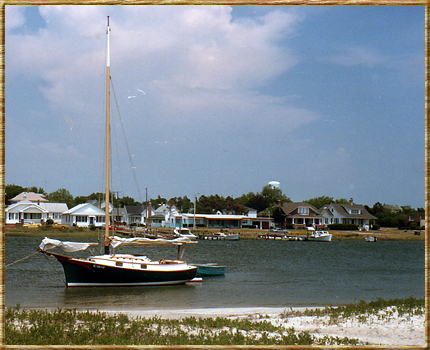 |
|
Picture of a full model of my boat that my wife Marcia had built for me. |
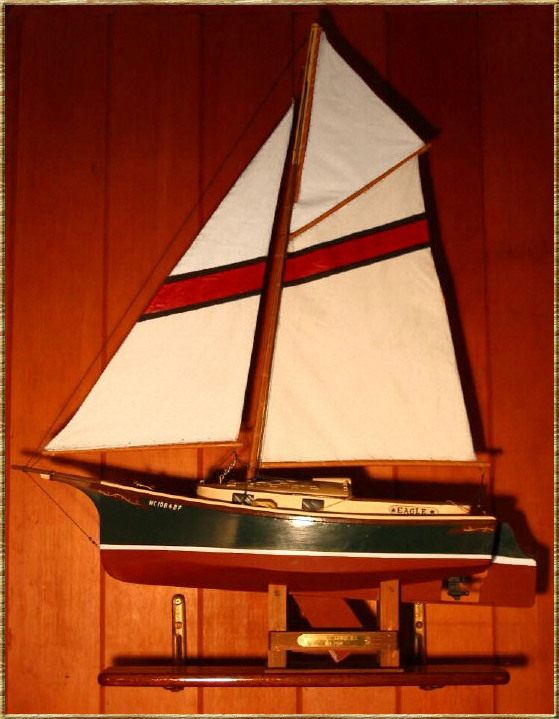 |
Herreshoff Eagle "Nutmeg of Consolation"
|
I've been (slowly) restoring for the past three years; she's spent the last decade or so on blocks in a boat yard in Southern Maryland, virtually abandoned by the previous owner. After I launch her next spring, I'll be keeping her on the Potomac River in a place called Stratford Harbor about 40 miles south of Washington, though I live in Waldorf, Maryland. I'll send along some photos for the Web site presently, and in a year or so might have a photo of her sailing in Washington, D.C., with the Washington Monument or Jefferson Memorial in the background. By the way, I own several original Nowak & Williams flyers I picked up at the Annapolis Boat Show in 1974--have had them in a drawer ever since. Took me 27 years to finally own one. I suppose she was worth the wait--but I'd much rather have bought one in 1974. |
Nowak & Williams, Bristol RI 1974 #089 |
Herreshoff Eagle "Liebe"
Liebe is now sailing on Temiscaming lake, Canada, after scouting sister lake Kipawa for 20 years. Liebe have is Canadian citizen passport now need to fly in US, but seat are sadly too small for her. Fresh water diet could be to blame.
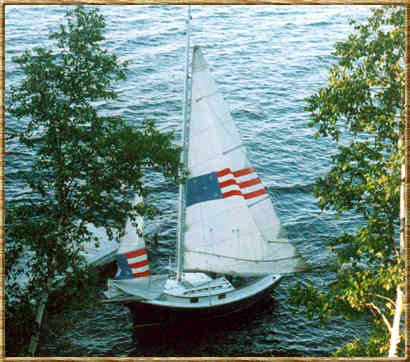 |
Nowak & Williams, Bristol R.I. bicentenial US edition (1776-1976) 1976 Hull #114 |
|
Liebe (love) is on this lake
since 15 to 20 years. The marconi rigging is very easy to sail. This
boat can stay 10 to 20 minute strait, on reach, hands off. It smell
the wind I guest! It is sailing on the beautiful Kipawa lake in the
Quebec province. The biggest town around is North Bay ONT.
|
 |
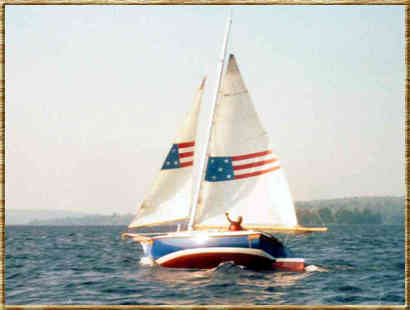 |
This special edition feature
a self tackin gib and extend main sail.The 20 ft main sail carry a US
flag design, being complete on the gib sail. An eagle sculpture complete
the ship front design as usual.
|
Herreshoff Eagle "Gato del Mar"
|
|
Squadron Yachts, Bristol R.I. 1978 |
|
I've been sailing Gato del Mar on Pleasant Bay at the elbow of Cape Cod for over 10 years and find her a perfect boat for the shoal waters of this estuary. This year I had some new tanbark sails cut at Thurston Sails in Bristol, RI, where the boat was built by Squadron Yachts in 1978. I keep her at Arey's Pond Boatyard surrounded by traditional Cape Cod catboats. |
Designed by
Text from Nowak & Williams 'our fleet' brochure...
The ultimate pocket yacht
In the stable and genteel manner of the last century, the Herreshoff Eagle is a stately daysailer and elegant weekend cruiser for two.
Fiberglass with varnished mahogany trim, sloop rigged with topsail, she is a well-found 22-footer replete with details attendant to comfortable sailing: wheel steering, aluminum spars, stainless steel standing and dacron running rigging, self contained head, sink, four fixed and one opening ports, 700 pounds of internal lead ballast and polished bronze fittings.
With shallow draft and retractable center-board, the Eagle is easily trailered. Concealed inside her large cockpit is an outboard motor well.
Rigging the Eagle

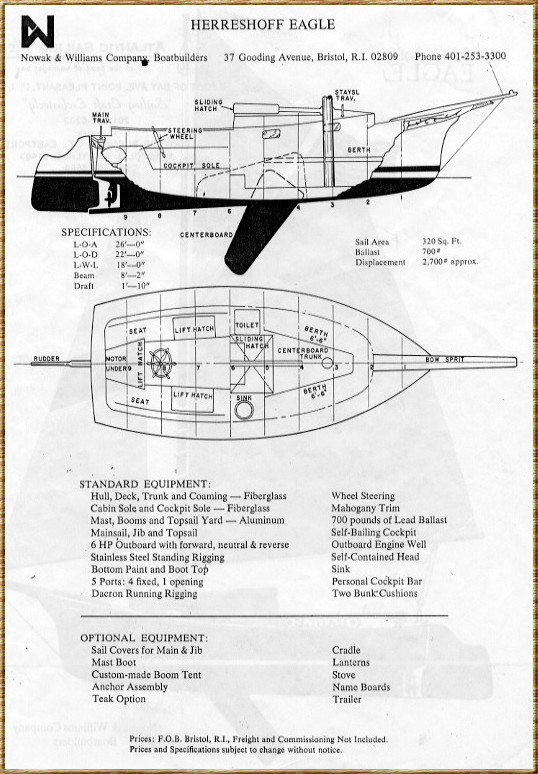
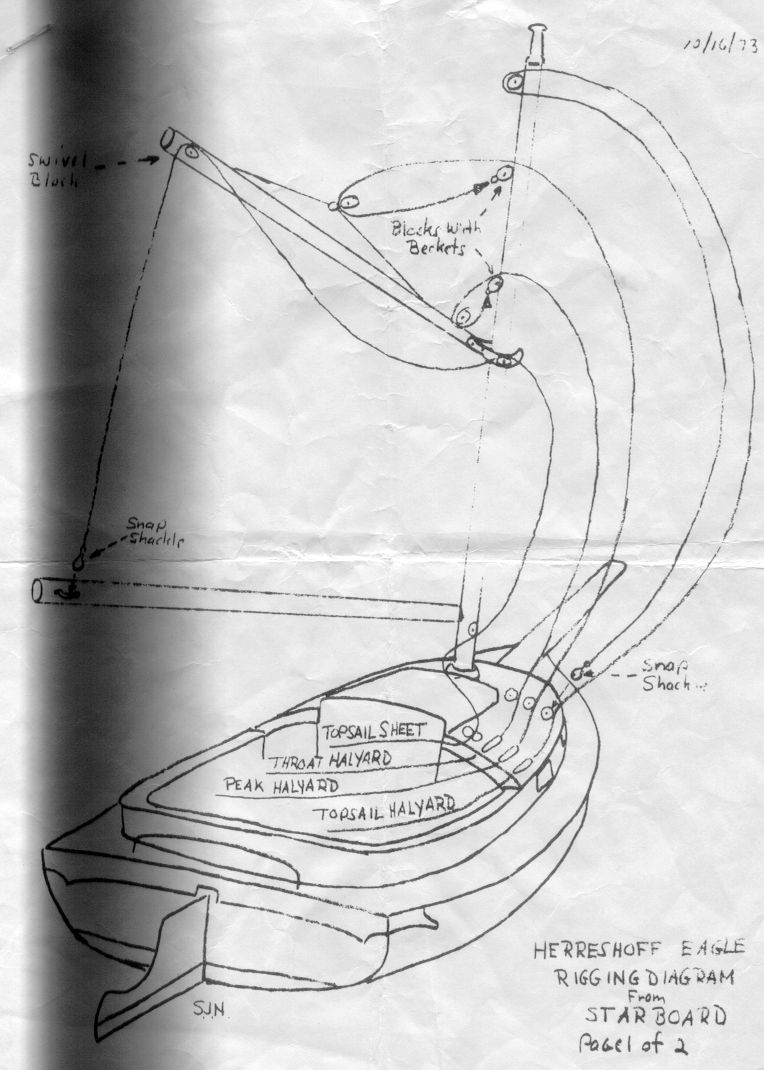
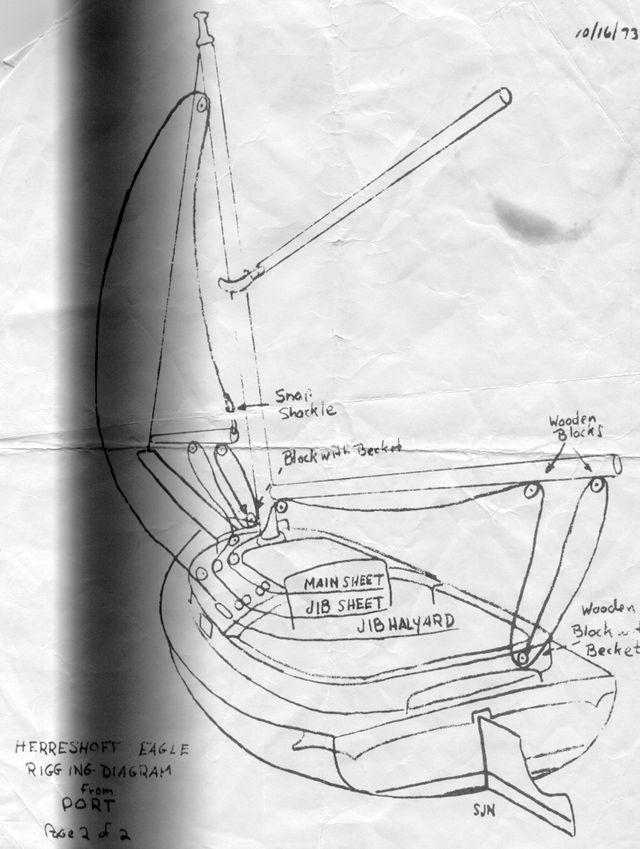
Rope Specifications:
(3/8" double braided dacron)
Main Sheet=85' Jib Sheet=50' Gaff Throat Halyard=60' Gaff peak Halyard=75' Jib Halyard=65'
(1/4" twisted or braided line)
Topsail Halyard=60' Topsail Sheet=75' Topsail Downhaul=7'
(1/8" single braided dacron)
Owner's flag Halyard=65'
(Marlin)
15' for fastening shackles to mast hoops
The following is copied verbatim from the typed documentation provided by Nowak & Williams
RIGGING THE HERRESHOFF EAGLE:
There is a box of hardware and rigging in your Herreshoff Eagle. Also find a checkoff list of items included in the rigging box. Check over the list and ascertain that everything that should be there, is there.
Also make sure you can identify all the items in the Rigging Box. The teak truck is that 16 inch, turned spindle which goes on top of the mast. Stepping wedges are for securing the mast at the point where it goes through the cabin top. Becket Blocks have an additional, small metal loop on them onto which a line can be tied. Snap hook shackles have a spring loaded locking finger while screw shackles have a screw, locking pin.
Now get orginized. Spread out your hardware on a towel. Put like things together. Seperate out your lines, blocks, stays, shrouds, etc. You should also have a screwdriver, pliers, wrench and a roll of masking tape within easy reach.
SPARS:
Now line up your spars: mast, main boom, gaff boom and jib club boom. Right now you will be working mostly with the mast so set the main boom and the jib club boom and the gaff boom aside.
MAST HOOPS:
Step one is to take the mast hoops and tie a screw shackle onto each one with marlin. PUT THE HOOPS ON THE MAST NOW ! REPETE PUT THE MAST HOOPS ON THE MAST NOW! Fit them over the top of the mast and bring them down to the hoop finger on the front of the mast, just above the main boom goose neck collar. You will have to remove the mast eyebolts to get the mast hoops on. Replace the eyebolts securely.
TRUCK & FLAG HALYARD:
First take the teak truck and insert it into the top of the mast. You may have to force it a bit as it is designed to fit snugly. Make sure the halyard holes in the truck are pointed to the side, the port side. Secure the truck with two set screws.
Now thread the 1/8" owner pennant halyard through the hole in the truck and tie on the two, small, flag halyard shackle with bowlines and hook them together.
BLOCKS AND MAST HALYARDS:
Now locate the eye bolts and finger tangs on the mast. Blocks will be attached to these eye bolts and then halyards will be threaded through.
JIB HALYARD:
Locate the double finger on the front of the mast. Take a screw shackle and a regular block and attach the block to the lower tang finger. This is the jib halyard block. The upper tang finger will be used for the headstay.
Now find the jib halyard and thread it through the block fore to aft. Find a #1 spring snap, shackle and tie it with a bowline to the forward end of the jib halyard.
TOPSAIL HALYARD:
Now lets turn to the top-aft end of the mast. Screw shackle a regular block to the top eyebolt of the mast and thread the Topsail halyard through the block fore to aft. Tie a #1 spring , snap shackle to the aft end of the topsail halyard with a bowline.
GAFF HALYARD:
The second, and third aft eye bolts from the top of the mast take becket blocks. Secure them with screw shackles.
GAFF PEAK HALYARD:
Tie the gaff peak halyard to the becket of the becket block on the second, aft eye bolt of the mast with a bowline.
Now thread the gaff peak halyard through a free regular block and pull the block down far enough on the halyard so that it touches the main boom gooseneck collar at the bottom end of the mast.
Now thread the gaff peak halyard back through the becket block, top to bottom and secure the loose halyard to the mast with masking tape.
GAFF THROAT HALYARD:
Tie the gaff throat halyard to the becket block on the third aft eye bolt of the mast with a bowline.
Now thread the gaff throat halyard through a free regular block and pull the block down far enough on the halyard so that it touches the main boom goose neck collar at the bottom of the mast.
Now take the longest stay-the mast headstay, remove the cotter pin and clevis pin on the swedged end and attach the swedged end to the tang on the fore top of the mast.
Attach the two shrouds to tangs on the port and starboard sides of the mast respectively.
Secure the increasing number of halyards and stays to the mast with masking tape.
Now secure with screw shackles 6 regular blocks to the 6 pad eyes on the cabin top to the port and starboard of the mast collar. We will refer to these blocks as P1, P2 and P3 on the port side and S4, S5 and S6 on the starboard side reading left to right.
Find the two 3/8" shroud turnbuckles and attach them to the chainplate on the port and starboard toerails just forward of midships.
STEPPING THE MAST:
Now take a rest because the next step is stepping the mast. The Eagle mast weighs seventy pounds. A lift is recommended for stepping the mast.
If the mast must be stepped by hand, There should be at least three people available to do the job
In hand stepping the mast, lay the mast along the wharf beside the boat. Lift the mast to about cabin height. Have one man at the mast collar hole at the cabin. Place the foot of the mast into the hole and start lifting by walking from the middle of the mast forward.
When the mast is vertical have a man go below and rotate the mast into the mast stepping slot.
Now fit the mast stepping wedges equally around the mast at the mast collar hole in the cabin top.
TURNBUCKLES:
Attach the mast shrouds to the chainplate turnbuckle. Do not tighten the turnbuckles beyond securing the shrouds at this time.
Find the jib club boom and fit the jib club boom turnbuckle goose neck to the pad eye on the forward end of the bow sprit.
Now attach the head stay to the jib club boom turnbuckle.
Now tighten up the shroud and head stay turnbuckles until the mast appears straight to the eye from all angles.
Insert the small cotter pins in the turnbuckle screw shafts. If you wish you can also wrap the turnbuckles with plastic waterproff tape, but it is not necessary.
THE JIB BOOM:
Attach the jib club boom gooseneck fitting to the head stay turnbuckle with the clevis pin and cotter pin provided.
THE GAFF BOOM:
Locate the mahogany boom crutch and insert it in the boom crutch holder on the aft deck combing.
Locate the gaff boom ( one with jaws ). Untie the rope jaw lock and put the jaw around the mast. Lay the gaff boom on the boom crutch and retie the rope jaw lock.
Locate the free block on the gaff throat halyard (coming from the third eye bolt on the aft side of the mast) and secure the block to the eye strap on the top side of the gaff jaws with a screw shackle. (Be careful not to twist the halyard when mounting the block).
Now locate the free block on the gaff peak halyard (coming from the second eye bolt on the aft side of the mast) and secure the block to the O ring in the center of the wire bridle on the top center of the gaff boom. Again, be careful not to twist the halyard when mounting the block.
SECURING THE HALYARDS:
Now carefully lead the mast halyards through the deck blocks. Starting with the jib halyard at the fore top of the mast. You have already tied a #1 spring, snap shackle to the forward end of the halyard with a bowline, now hook the spring, snap shackle to the tang on the end of the jib club boom. Lead the other end of the jib halyard through the deck block P1 and cleat the end to the bar cleat on the furthest port side side of the cabin top.
Now locate the topsail halyard, which is the topmost aft halyard on the mast. Hook the topsail halyard's snap shackle to the small eye strap on the starboard side of the mast just below the main boom goose neck collar. Now lead the other end the topsail halyard fore to aft through deck block S6 and attach the halyard to the right hand bar cleat on the starboard side of the cabin top.
Now lead the gaff peak halyard, which is the second aft halyard on the mast, fore to aft through deck block S5 and attach it to the middle bar cleat on the starboard side of the cabin top.
Lead the gaff throat halyard, which is the third aft halyard from the top of the mast, fore to aft through deck block S4 and attach it to the left hand bar cleat on the starboard cabin top.
THE MAIN BOOM:
Now get the main boom in place by attaching the main boom goose neck fitting to the main boom mast collar with the key lock.
THE MAIN SHEET:
Fit the only wooden cheek block with a becket to the main sheet traveler on the aft deck of the boat with a screw shackle. Use a screw shackle to attach two standard wooden cheek blocks to the two aft most bales on the end of the main boom. (Note the bale in the center of the boom is used as a lizard for the main sheet and doesn't carry a block).
Find the only 45 degree twist shackle in the hardware box. It looks like a regular pin shackle except the arms are twisted 45 degrees. Use the twist shackle to fasten a standard block to the bale on the af side of the mast just below the main boom gooseneck collar. Now find the main sheet. Tie one end with a bowline to the becket of the main sheet block on the traveler.
Now lead the main sheet fore to aft through the aft most wooden cheek block on the main boom and back through the traveler-block aft to fore.
Now lead the main sheet aft to fore through the next aft block on the main boom, through the lizard bale at mid boom, and finally through the wooden cheek block at the mast top to bottom.
Now lead the end of the main sheet aft on the port side of the cabin top and through the fairlead of the right hand cam cleat.
Secure the main sheet in the jaws of the cam cleat.
THE JIB SHEET:
Attach a standard block to the jib traveler with a screw shackle.
Attach a bronze becket block to the aft bale on the jib club boom with a screw shackle. Attach a standard block to the second aft bale of the jib club boom with a screw shackle.
Attach a final bronze standard block to the pad eye on the cabin top just in front of the jib traveler.
Now locate the jib sheet. Tie one end with a bowline to the becket on the aft end of the jib boom.
Lead the jib sheet fore to aft through the block on the jib traveler back through the becket block aft to fore. Now lead the jib sheet through the second jib club boom blockaft to fore, down through the deck block fore to aft, through P2 fore to aft and finally through the fairlead of the left hand cam cleat on the port side. Secure the jib sheet in the jaws of the cam cleat.
THE TOPSAIL SHEET:
Locate the topsail sheet. Tie a #2 spring snap shackle with a bowline to one end of the topsail sheet. Hook the spring snap shackle to the eye strap located on the port side of the main boom just forward of the reefing pennant cleat.
Lead the topsail sheet aft to fore through the swivel block on the port side end of the gaff boom. Now lead the topsail sheet forward and down theough the small cheek block on the port side of the gaff boom jaws. Now lead the topsail sheet down and fore to aft through the small cheek block on the forward port side of the mast. Finally lead the topsail sheet aft on the port cabin top through the fairlead of the port side cam cleat and secure it in the cam cleat jaws.
SAILS:
Insert the three battens into the mainsail batten pockets.
Bend the mainsail foot onto the main boom.
Open each mast hoop shackle in turn and attach it to the small grommets on the luff of the mainsail. (Avoid attaching a mast hoop to the largest grommets on the luff. The large grommets are for the gooseneck fittings on the very top and bottom of the luff and the reef point about two feet up on the luff from the bottom).
Bend the mainsail head onto the gaff boom.
Secure the sail head and foot to the gaff jaws and main boom goose neck respectively with the lock key provided at each point.
Attach 1/4" dacron line (no nylon, it streches) to the clew grommets of the mainsail and secure the sail on its outboard ends to the outhauls located at the end of the main boom and the gaff boom.
Bunch the sail by pulling it aft and rolling it into itself. Tie on three sail stops to secure the sail.
Hook the snap shackles of the jib luff to the head stay. Fasten the foot of the jib luff to the gooseneck fitting. Use 1/4" dacron line to secure the clew of the jib to the outhaul fitting of the jib club boom. Curl the jib and secure it with two sail stops.
ENSIGN FITTINGS:
There is an eye strap on the aft end of the boom on the starboard side.There is also an eye strap on the starboard aft side of the gaff boom. These eye straps are for the spring snap shackles for an American flag.
If you purchase an American Flag Ensign (3' x 4') and wish to fly it, tie on a 2' piece of 1/4" shock cord and a #1 snap hook shackle to the top of the ensign and a 23' piece of shock cord with another #1 snap hook shackle attached to the bottom grommet of the ensign. Hook the snap shackles to the eye straps before you hoist the mainsail. When the main is up, you will be proudly flying the colors as depicted in the Herreshoff Eagle brochure.
THE MAST BOOT:
A cloth mast boot is included with each boat. One end of the mast boot is stitch finished; the other is not.
Take the unfinished end with about 5 short vertical cuts on the unfinished edge. Wrap the mast boot around the mast at the cabin top with the velcro seam facing aft. Note the position of the scissor cuts relatave to the mast and mark it.
Now turn the mast boot inside out so it looks like an ice cream cone. Line up the marks on the mast with the end of the scissor cuts inside out and upside down and wrap with tape.
Now pull the mast boot down over the tape and secure the velcro seam. The boot should provide water tight protection over the stepping blocks.
THE TOPSAIL DOWNHAUL:
The last line in your Rigging Box is the Topsail Downhaul. Fit it with a 1"snap hook shackle and tie it to the foot clue of the topsail.
When the topsail is raised on its halyard, the topsail downhaul should be adjusted so that the luff of the topsail is taught. From that point on the setting of the topsail will require only the hooking of the downhaul snap shackle to the eye strap on the bottom of the mast (starboard side) and the hoisting of the sail.
NOW GET READY FOR A SEASON OF FUN SAILING
I have qiute a few typed & hand-written pages from Nowak & Williams that I will post when I get a good scanner. Here's a little text from a couple of them...
The topsail is an important part of your Eagle. You should use it regularly. It is so easy to use, I am sure that with a few hoistings you will become completely familiar with the sail.
To set the topsail merely clip the topsail halyard onto the head of the sail; snap the downhaul onto the eyestrap on the bottom starboard side of the mast; take the topsail sheet from the main boom, attach it to the topsail clew and hoist the halyard. Now tighten the downhaul sheet and your underway.
We hope you enjoy the boat as much as we do in building it.
The Eagle is designed as a balanced boat. She will sail on course with a neutral helm in winds under ten knots without tending the wheel. Just set your main and jib sheets to wind conditions and watch her perform.
The topsail is your third sail. It should be used in winds up to fifteen knots for extra speed on and off the wind.
The Eagle is a good sea boat and should outride many larger boats in rough water. You will also be pleased that, even in the roughest water, the Eagle will remain dry. The hull is designed to throw water to the side and help keep the crew dry.
If you own an Eagle or have any information please email
updated 4-14-08